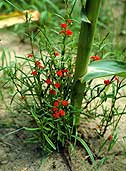In Latin America, agrarian land reform is often proposed as a measure to distribute lands to the landless. It involves taking over large properties without just compensation and usually is an attack upon the right of private property.
However, there are conditions when it can be justified. First, the measures employed cannot be socialist and confiscatory as has usually happened in most Latin American proposals. Proper compensation must be given for any lands taken.
 Secondly, it must also be established that the specific use of the property by the owner clearly runs contrary to the common good. In other words, it cannot be a blanket policy affecting all landowners but only be applied to specific and rare circumstances as a last resort.
Secondly, it must also be established that the specific use of the property by the owner clearly runs contrary to the common good. In other words, it cannot be a blanket policy affecting all landowners but only be applied to specific and rare circumstances as a last resort.
Take for example a landowner who controls huge tracts of land. Production has slumped for years and weeds are taking over unopposed. The area used to be self-sufficient but now must import food at great cost.
The neglect of the lands also has repercussion outside the farms. Nearby food processing plants have closed and thousands of workers laid off. The large landowner has so monopolized the market that all the remaining small farmers own just 15 percent of the land.
Clearly such a situation would call for intervention. It is only right that measures be taken under the conditions cited above to remedy this concrete situation. Since there are no other properties nearby, lands should be bought and made available to local farmers.
Reuters recently carried a story chronicling the abuses of one Latin American landowner which it qualified as “perhaps the largest unproductive landowner in Latin America.” The sickly person responsible for the lands has for decades ranked among the richest persons in the country.
However, conditions on this latifundio have reached a critical phase that would rightly call for an extraordinary land reform.
Production on the lands has almost ground to a halt. Equipment, fertilizer, seed, pesticides and farm equipment acquisition has been cut by as much as 80 percent.

Worst of all, nearly a third of all arable lands have been overrun by a prickly waist-high weed called “marabu” which the farmers call the “witch’s weed” since it makes pastures useless. Not even goats will eat the weed. Sugar mills used to dot the countryside in the good old days, but now half of them lay idle adding to the depressing atmosphere of the area. Farmers complain that, if given a change, they could have the place producing abundant food for the population.
One would expect that exposure of this grave situation in the world press would be enough to launch a worldwide campaign to remedy the situation. Thanks to The New York Times and all the major papers carrying the Reuters story, the local farmers finally have a voice that should spur indignation and bring relief.
Activists the world over, should now take up their cause forcing the ownership transfer of these lands. Latin American religious groups who have been so vocal on this issue should make this a cause celebre.
However, there is no danger this landowner will lose control of these lands. In fact, the Reuters story waxes optimistically on efforts by the brother of the present person in charge to make things better despite the fact that the lands have languished for nearly fifty years in this sad state.
Where are these Latin American lands that are so ill-used and these worker that are so abused? They are not in booming agriculture giant Brazil or Argentina or Bolivia.
No, these lands are those on the whole island of Cuba where the landowner is the Cuban State under the direction of the region’s last remaining dictator Fidel Castro.1
.jpg)
The dismal state of Cuba, so well illustrated by this casual and optimistic Reuters’ story, is so ignored by the major media. On the contrary, they do everything possible to whitewash the real situation in the decrepit communist regime. Readers are asked to believe that the same system that has produced such an agriculture fiasco also produces yet another great illusion supported by major media: Cuba’s substandard medical system – cited as a model for America’s own system.
The reality is completely different. After fifty years of socialist agriculture, it seems the crowning accomplishment of the State landowner is the production of three million acres of witch’s weed. Maybe one dismal system supports the other and witch’s weed has its medicinal uses.

